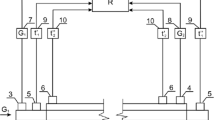One way to limit excursions above the standard oxygen and moisture concentrations is to organize gas exchange in the float bath; this ensures that the oxygen and moisture are continually removed to admissible concentrations. Such gas exchange can be organized by continually feeding into the bath a definite amount of a protective nitrogen – hydrogen mixture, i.e., a definite number of gas exchanges must be performed. A method of determining the number of gas exchanges in a float bath, taking account of the gas-tightness of the bath and the amount and quality of the protective mixture fed into it, is examined. Techniques that give the required number of gas exchanges are proposed.
Similar content being viewed by others
References
K. T. Bondarev, Polished Sheet Glass [in Russian], Stroiizdat, Moscow (1978).
H. A. Schaeffer and K. H. Hausner, The Technology of Glass [Russian translation], CTI-Print, Kishinev (1998).
H. Jebsen-Marwedel and R. Brueckner, Forms of Scrap in Glass Production [Russian translation], Stroiizdat, Moscow (1986).
V. N. Bogoslovskii, V. P. Shcheglov, and N. N. Razumov, Heating and Ventilation [in Russian], Stroiizdat, Moscow (1980).
V. E. Bakhirev, V. N. Bryzgalin, M. L. Glikman, and V. F. Tarasov, “On the admissible concentrations of impurities in the protective atmosphere,” in: VNIIstroisteklo, deposited in VNIIIÉSM April 30, 1975 [in Russian], No. 135.
L. Ya. Povitkova and V. Soldatova, “Study of the dependence of certain operational properties of heat-polished glass on the glass production conditions,” in: Quality of Glass Sheets [in Russian], Saratov (1981), pp. 82 – 85.
V. I. Kondrashov, V. S. Bezlyudnaya, and Yu. V. Zverev, “Effect of formation regimes and methods on the tin content in float glass,” Steklo Keram., No. 6, 6 – 7 (1998).
V. F. Tarasov, Investigation of the Mechanism of Bubble Formation at the Interface between Phases During Glass Production on the Surface of a Fused Metal, Author’s Abstract of Candidate’s Thesis [in Russian], Leningrad (1974).
V. A. Kireev, Methods for Performing Practical Calculations in the Thermodynamics of Chemical Reactions [in Russian], Khimiya, Moscow (1975).
Author information
Authors and Affiliations
Additional information
Translated from Steklo i Keramika, No. 5, pp. 24 – 25, May, 2009.
Rights and permissions
About this article
Cite this article
Bezlyudnaya, V.S., Kuznetsova, O.V. & Pentko, Y.N. Method for evaluating and maintaining the required gas exchange in a float bath. Glass Ceram 66, 176–178 (2009). https://doi.org/10.1007/s10717-009-9159-x
Published:
Issue Date:
DOI: https://doi.org/10.1007/s10717-009-9159-x




